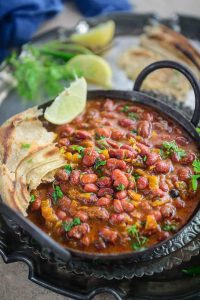Rajma is my identity, culture, and a representation of myself. Okay, wow, that’s a bold statement. Sure it is, but give me the next couple minutes to explain myself, starting with where I was born. I was born in 1996, in Mumbai, India, to a Punjabi mother and a Maharashtrian father. While they were both Indian, they grew up in different regions each with their own unique cultural upbringings. One of the biggest differences was not in what they wore, what language they spoke, or even what God they worshipped, rather it was in their food.
One of the most popular traditional dishes in India is rajma, which is essentially red kidney beans in a thick gravy. Sounds rather mundane right? Well, the beauty and uniqueness of rajma lies in the spices used. As my mother is Punjabi, the spices that her family used were native to the Northern region of India, and my Nani (grandmother) on my mother’s side used Punjabi spices like black cardamom, black cumin, nigella seeds, and mace in their rajma preparation. This added a spicy kick to the dish, usually leaving me chugging cups of water and milk. On the other hand, my father’s Maharashtrian family were more accustomed to preparing their rajma with milder, but richer spices, such as turmeric, basil, fresh coriander, and saffron. Each side of the family would put their own traditional twist on it, resulting in vibrant, aromatic flavors representative of both the Northern and Western regions of India. On both sides of my family, the recipe for making rajma had been passed down for generations, evolving over time, and as a result, no one preparation of rajma in India tastes the same. When I was a child, I remember being fascinated by stories of how the rajma that I eat at home today is a mixture of both my mother and father’s sides of the family. It is essentially a middle ground between each of my grandmother’s recipes. Between you and I, the rajma I eat today is really 30% of my dad’s recipe and 70% of my mum’s recipe. My mum hates to admit it, but she just can’t live without her nigella seeds and mace, which add the biggest kick of flavor and heat to any dish I have ever eaten.
Contrary to popular belief, the red kidney bean stew is not actually traditional to India, in fact, this bean was brought over to India by Portuguese traders. The original rajma bean is native to the New World: Mexico and Guatemala. In the 15th Century, when Spanish and Portuguese conquistadors occupied territories in the New World, they brought back this delicious bean to Europe. These beans, rich in protein for sailors, were soon carried to Portuguese outposts in Africa and Asia. But Rohan, how does this have anything to do with your identity?After I was born in India, my family and I moved around and lived in several different countries. As a result, I gained a significant amount of cultural awareness, and understanding of my cultural identity. Just as how the red kidney bean stew had travelled from Mexico to India, its recipe changing over time, I too have traveled from country to country, broadening my cultural awareness and establishing my cultural identity. As much of a stretch as this may seem, I am the rajma in this story.
Nowadays, every time I visit my grandmothers in India, instead of them making their rajma dishes for me, my parents and I make our fusion rajma dish for them. Not only have they appreciated the role reversal, but they love watching how our family recipe has changed and developed over time, incorporating spices from each side of the family, as well as spices from each country we have lived in. At its core, red kidney bean stew is such a versatile dish, and every culture has put their own twist on it. For a majority of the Western world, the red kidney bean presents itself in the form of the delicious all-time favorite breakfast dish: baked beans. Whereas in Mexico, the red kidney bean is used in popular dishes such as chili con carne. Everywhere I lived and travelled, I tried each countries unique version of the red kidney bean stew. While I enjoyed immersing in their culture, and tasting their exotic take on this delicious dish, my true identity lies with my family’s version of rajma.
Unfortunately, over the past few years, I have found it difficult to travel back to India and spend time with both my grandmothers. I miss them both very much, but thanks to my mum’s frozen food care-packages, my grandmothers don’t seem that far away. Whenever I miss my family back in India, I walk to the fridge and heat up a delicious, bowl of rajma. Tasting each scoop is like traveling back in time to all the countries I have ever lived in, finally landing back to my roots in my grandmothers Punjabi and Maharashtrian recipes. One day, I look forward to seeing how my family’s rajma recipe alters to incorporate the culture of my future life-partner. I am proud of my family’s recipe, and I will cherish the memories that were created because of this dish. Rajma will forever be my identity, culture, and a representation of myself.
Recipe
Ingredients
To boil:
- 1 cup red kidney beans (rajma), washed and soaked overnight
- 2 bay leaves
- 8 green cardamom
- 3 black cardamom
- 6-8 cloves
- 1-2 cinnamon sticks
- 5 cups water
For the masala:
- 2 small or 1 big onion, grated
- 1 tbsp ginger paste
- 1 tbsp garlic paste
- 2 tbsp oil
- 1 tsp cumin seeds
- 3 roma tomatoes
- 2 tbsp cilantro leaves
- 3-4 green chillies
- ½ tsp coriander powder
- 1 tsp red chilli powder
- ¼ tsp turmeric powder
- 1 tsp aamchoor powder
- 1 tbsp rajma masala/ garam masala
- 1 tbsp kasoori methi, crushed
- 1 tbsp clarified butter/ghee, optional
Instructions
For the Kidney beans:
- Soak the red kidney beans overnight. Drain the water and wash them. In a pressure cooker, add the red kidney beans, 3.5 cups water, bay leaf, cardamom, black cardamom, cloves and cinnamon stick. Pressure cook with 1 tsp salt till the beans are soft. It usually takes 1-2 whistles for me, but depending on how long you soak the beans and your cooker, it might take more whistles.
The slow cooker version:
- If you hate cleaning the pressure cooker like I do, I have now started making this in the slow cooker. I am yet to try a version where I dump everything in the slow cooker and let it do all the work, but I do the final part of the cooking in the slow cooker. I do boil the beans with the whole spices on the stove first for 15 minutes to avoid red bean poisoning. Once boiled, I put them with the spice and water in the slow cooker and cook on high with the cooked masala added.
For the masala:
- In a blender, puree together the tomatoes, coriander leaves and the green chillies.
- In a wok (kadhai), heat 2 tbsp oil. Add the cumin seeds and let sizzle. Add the grated onions and fry till golden brown, about 8 minutes on medium flame. Add the ginger-garlic paste, turmeric powder, red chilli powder and coriander powder. Sauté for a minute or two on medium flame.
- Add the pureed tomato mixture and fry till the oil separates (can take about 15-20 minutes). At this point, you can freeze this masala and use it later.
Putting it all together
- Pour the cooked rajma masala in the cooker with the boiled rajma. Mix. Mash some beans with the back of your ladle. Add salt, if necessary. Add the rajma masala/garam masala powder and the amchoor powder, and 1 tbsp ghee (optional). Add the kasoori methi.
- Once the masala is poured in with the boiled rajma, you should let cook on medium flame for about 10-15 minutes for all the flavors to be soaked in by the kidney beans.
If using the slow cooker:
- Add the rajma masala to the partially boiled beans in the slow cooker. Cook on high for 6 hours.
- Garnish with coriander/cilantro leaves. Serve hot with rice and curd.
Recipe courtesy of: http://www.novicehousewife.com/2010/09/02/punjabi-rajma/
Unfortunately, I do not have any pictures of the rajma my family has cooked, but for your reference, this is a picture of a full preparation of rajma (I wish I could make something that aesthetically pleasing).

Picture credits: https://www.whiskaffair.com/punjabi-rajma-masala/
The following is a picture of my Nani (from my mother’s side) and I in our house in Mumbai, India. I am guessing her big smile is from the delicious rajma I just made for her!


Rohan, this is a particularly engaging essay! You have a very lively voice that draws in your readers. I enjoyed getting to know how much rajma means to you, starting from how different Punjabi and Maharashtrian cuisines are as they approach rajma. I’m glad that the rajma you grow up eating has become a symbol of the unique cultural mixture between the two sides of your family. The rhetorical questions you make use of from time to time are very effective–they serve as signal and reminder to the key issues of your essay. They are also a sure sign of the high level of reflectiveness you’re capable of as a writer–also evident in comments like “I am the rajma in this story”–well done! I’m sure in due time you will add something new to your family recipe and create something equally splendid. The only thing I would hope for is more clarity in terms of the recipe–I assume it’s copied from the source you cited? It would be great if you could share your unique family recipe, with 30% of your dad’s recipe and 30% of your mom’s.